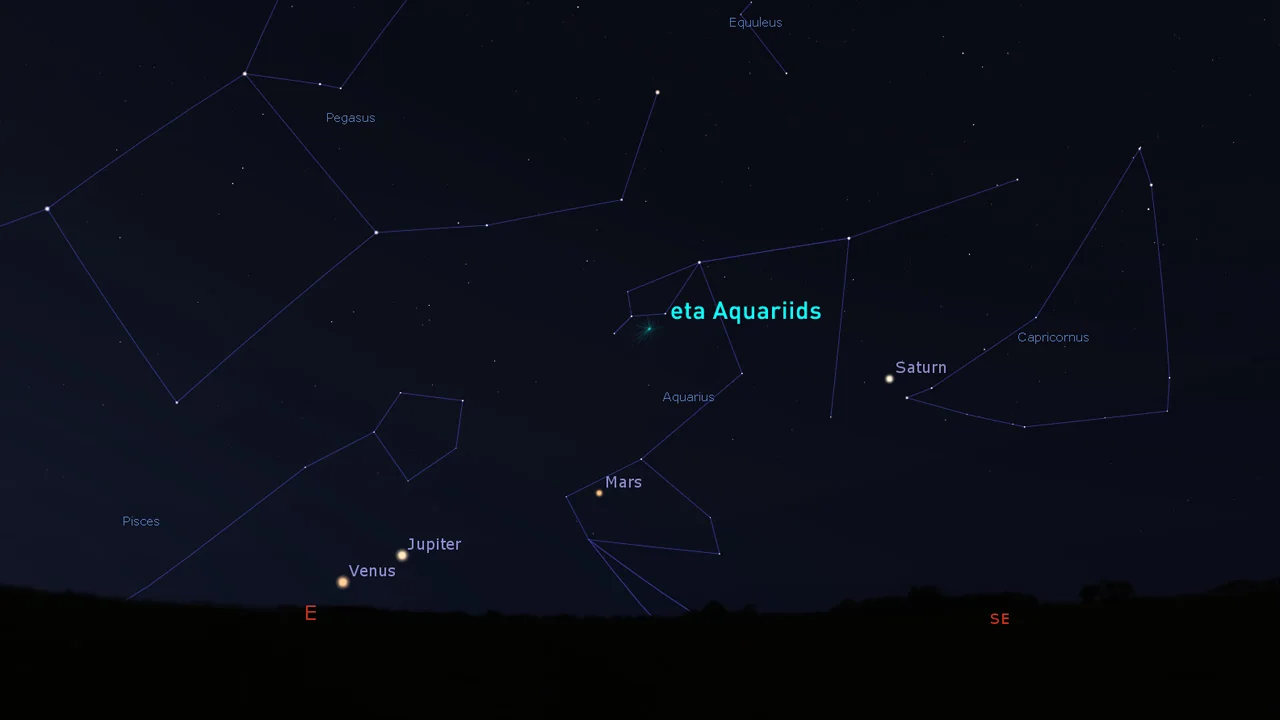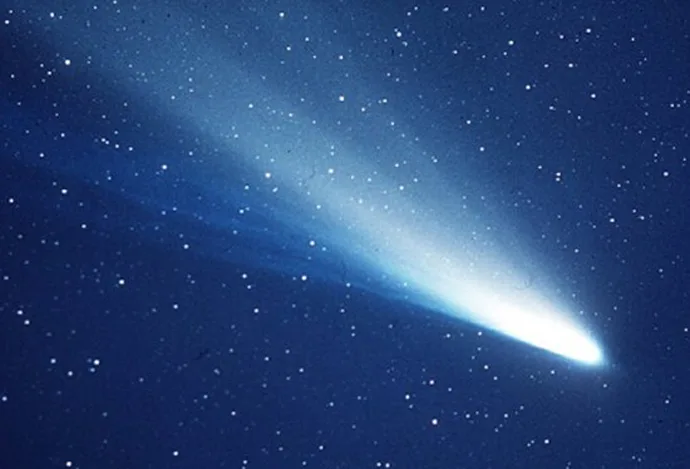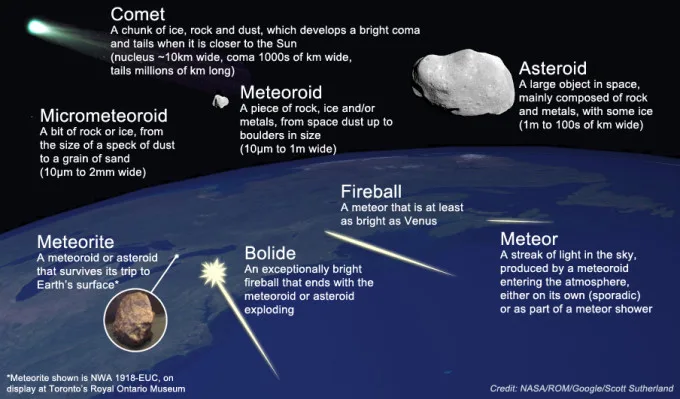
A Halley's Comet meteor shower is peaking. There's still a chance to see it!
You'll want to get up early on Friday morning for a chance to catch this celestial light show.
In the early morning hours on Friday, we have a chance to see bright streaks across the sky, thanks to Halley's Comet and the eta Aquariid meteor shower.
Comet Halley is probably the most well-known comet in the world, putting on a spectacular show every time it flies past our planet. However, it only does so once every 75 years.
Twice each year, though, we get a reminder from 1P/Halley that it's only a matter of time before it comes back for another pass. The first such reminder arrives starting in the middle of April, and lasts until the end of May, in the form of bright streaks of light across the night sky.
This is the eta Aquariid meteor shower, and it reaches its peak — when we can see the greatest number of meteors — in the predawn sky on either the 5th or 6th of May.

The radiant of the eta Aquariid meteor shower, in the hours before dawn on May 5. Also look for a lineup of Venus, Jupiter, Saturn, and Mars. Credit: Stellarium/Scott Sutherland
It's at this time of the year when Earth is making its first pass through the stream of dust and ice left behind by 1P/Halley, as the comet swings through the inner solar system and around the Sun.
The peak of the meteor shower is when we cross the densest part of that debris stream. The planet makes a second pass through Halley's dust trail in late October, producing the Orionids meteor shower at that time.

Comet 1P/Halley. Credit: NASA
WILL WE SEE IT?
The best time to see the eta Aquariids is in the few hours just before dawn. The meteor shower 'radiant' — the point in the sky where the meteors appear to originate from — only rises above the eastern horizon at around 3 a.m., local time.
This year is better than most for the eta Aquariids. The shower peaks only a few days after the New Moon. Thus, there will only be a thin crescent Moon in the sky on Wednesday-Thursday night, and it will set quite early. So, it will not contribute to light pollution in the sky.
Sky conditions are another important factor. Check your cloud forecast for the early morning, to see if your skies will be clear enough.
If it is cloudy where you are, thus blocking your view of the meteor shower, there are other ways to check it out.
You can see the signal meteoroids make when they plunge into the atmosphere via Meteor Radar or listen to them via the Meteor Echoes Livestream.
WHAT CAN WE SEE?
The eta Aquariids typically produce around 50 meteors per hour for observers who have a clear, dark sky, with the meteor shower radiant directly overhead. Most observers tend to see about half that number, so around 20-25 per hour.
The flash of a meteor is the result of one of those bits of dust or ice from the comet debris trail (aka a 'meteoroid') hitting the top of Earth's atmosphere.

A primer on meteoroids, meteors and meteorites. Credits: Scott Sutherland/NASA JPL (Asteroids Ida & Dactyl)/NASA Earth Observatory (Blue Marble)
A typical meteoroid is travelling at around a hundred thousand kilometres per hour when it hits the top of the atmosphere. It very quickly compresses the air in its path, turning that air into a white-hot plasma! This glowing is the 'meteor' that we see streaking through the air, high above the ground.
All the while, the hot plasma is scorching the meteoroid and pressing back on it, causing it to slow down. The heat vaporizes smaller meteoroids. For larger ones, the force exerted on the meteoroid can be enough to shatter it! Once the meteoroid vapourizes, or slows down enough, the meteor winks out.
WATCH BELOW: METEORS SPOTTED FROM THE INTERNATIONAL SPACE STATION
This eta Aquariids meteor shower does not tend to produce bright fireballs, as the Lyrids do. The meteoroids are moving so quickly when they hit our atmosphere, however, that they can produce a phenomenon called persistent trains.
'PERSISTENT TRAINS'??
When a typical cometary meteoroid hits the top of Earth's atmosphere, it is moving fast enough to produce a meteor flash (as mentioned above). The particles in the eta Aquariid stream, however, hit Earth's atmosphere travelling at nearly two and a half times faster than average!
Streaking through the air at 240,000 km/h, meteoroids from Comet Halley produce the usual brief meteor flash. They can also result in a bonus. Once the meteor goes out, a glowing trail is left behind, floating in the air, called a persistent train. Some persistent trains last for minutes after the meteor flash, while others remain visible for hours.
Watch below to see a persistent train from the Geminid meteor shower
Since persistent trains have only rarely been recorded, scientists still aren't quite sure what causes them. Two basic ideas could explain them, though.
The first is that the meteoroids are travelling fast enough to strip electrons from the air molecules, leaving them in an ionized state. As the air molecules snatch up electrons from their surroundings, they release energy in the form of light. Since this process can take much longer than the original meteor flash, the 'train' appears fainter, and it can persist for some time after the meteor flash ends.
The other idea involves what is known as 'chemiluminescence'. Metals vaporizing off the surface of the fast-moving meteoroids can chemically react with ozone and oxygen in the air, to produce a glow.
One of these explanations may account for these 'trains', or both may cover different occurrences, at different times, and even between individual meteors. It will take more sightings of these to explain them fully.
TIPS FOR WATCHING A METEOR SHOWER
Given how polluted our night skies are with urban light, it is no longer a simple matter to step outside and gaze up at the stars. It's even more difficult to watch an event such as a meteor shower. Follow the tips below, though, and you won't miss out on these amazing events.
There are three best practices for observing the night sky:
Check the weather,
Get away from light pollution, and
Be patient.
Clear skies are essential. Even a few hours of cloudy skies can ruin your chances of watching an event such as a meteor shower. So, be sure to check The Weather Network on TV, on our website, or from our app, and look for my articles on our Space News page, just to be sure that you have the most up-to-date sky forecast.
Next, you need to get away from city light pollution. If you look up into the sky from home, what do you see? The Moon, a planet or two, perhaps a few bright stars such as Vega, Betelgeuse and Procyon, as well as some passing airliners? If so, there's too much light pollution in your area to get the most out of a meteor shower. You might catch an exceptionally bright fireball if one happens to fly past overhead, but that's likely all you'll see. So, to get the most out of your stargazing and meteor watching, get out of the city. The farther away you can get, the better.
Watch: What light pollution is doing to city views of the Milky Way
For most regions of Canada, getting out from under light pollution is simply a matter of driving outside of your city, town or village until a multitude of stars is visible above your head.
In some areas, especially in southern Ontario and along the St. Lawrence River, the concentration of light pollution is too high. Getting far enough outside of one city to escape its light pollution tends to put you under the light pollution dome of the next city over. The best options for getting away from light depend on your location. In southwestern Ontario and the Niagara Peninsula, the shores of Lake Erie can offer some excellent views. In the GTA and farther east, drive north and seek out the various Ontario provincial parks or Quebec provincial parks. Even if you're confined to the parking lot after hours, these are usually excellent locations from which to watch (and you don't run the risk of trespassing on someone's property).
If you can't get away, the suburbs can offer at least a slightly better view of the night sky. Here, the key is to limit the amount of direct light in your field of view. Dark backyards, sheltered from street lights by surrounding houses and trees, are your best haven. The video above provides a good example of viewing based on the concentration of light pollution in the sky. Also, check for dark sky preserves in your area.
When viewing a meteor shower, be mindful of the phase of the Moon. Meteor showers are typically at their best when viewed during the New Moon or Crescent Moon. However, a Gibbous or Full Moon can be bright enough to wash out all but the brightest meteors. Since we can't get away from the Moon, the best option is just to time your outing right, so the Moon has already set or is low in the sky. Also, you can angle your field of view to keep the Moon out of your direct line of sight. This will reduce its impact on your night vision and allow you to spot more meteors.
Once you've verified you have clear skies and you've limited your exposure to light pollution, this is where being patient comes in.
For best viewing, your eyes need some time to adapt to the dark. Give yourself at least 20 minutes, but 30-45 minutes is best for your eyes to adjust from being exposed to bright light.
Warning: This is possibly the one thing that causes the most disappointment when it comes to watching a meteor shower. Stepping out into the backyard from a brightly lit home and looking up for five minutes, you might be lucky enough to catch a rare bright fireball meteor. However, it's far more likely that you won't see anything at all. However, waiting for at least twenty minutes and avoiding sources of light during that time — streetlights, car headlights and interior lights, and smartphone and tablet screens — dramatically improves your chances of avoiding disappointment.
Sometimes, avoiding your smartphone or tablet isn't an option. In this case, set the display to reduce the amount of blue light it gives off and reduce the screen's brightness. That way, it will have less of an impact on your night vision.
You can certainly gaze into the starry sky while you are letting your eyes adjust. You may even see a few of the brighter meteors as your eyes become accustomed to the dark.
Once you're all set, just look straight up and enjoy the view!
